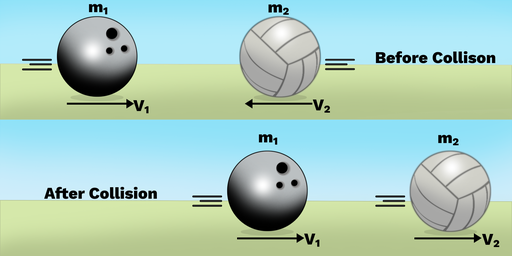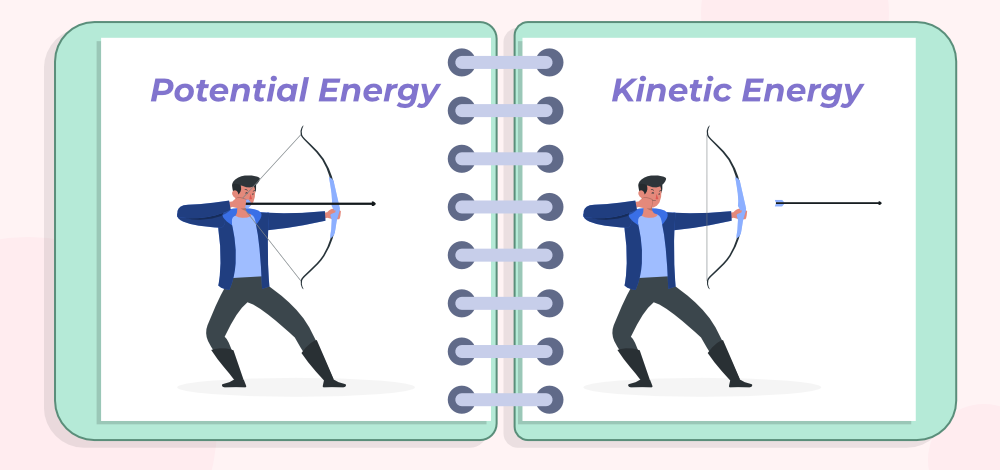Kinetic energy, one of the most well-known concepts in physics, is the energy an object possesses due to its motion. This energy relies on two crucial factors: the object’s mass and its velocity. The faster an object moves or the more massive it is, the higher its kinetic energy will be. This energy plays a vital role in every aspect of life, from the wind turning turbines to produce electricity to the functioning of our bodies at a molecular level. Let’s dive deeper into the world of kinetic energy.
What is Kinetic Energy?
Kinetic energy can be defined as the energy a body possesses due to its motion. This energy is an essential factor in work-energy theories in physics, describing the amount of ‘work’ an object can perform due to its motion. It is this energy that allows a moving car to cause a significant impact or a bullet fired from a gun to penetrate a target.
Kinetic Energy Formula
The formula for calculating kinetic energy is a crucial tool in understanding the energy associated with an object’s motion. It is given by:
KE = 1/2 * m * v2
This formula shows that the kinetic energy (KE) of an object is equal to one-half of the object’s mass (m) multiplied by the square of its velocity (v).
Kinetic Energy Equation
The kinetic energy equation is a mathematical representation of the relationship between kinetic energy, mass, and velocity. It shows that kinetic energy is directly proportional to the mass of the object and the square of its velocity. The equation is:
KE = 1/2 * m * v2
Kinetic Energy Units
In the International System of Units (SI units), kinetic energy is measured in joules, symbolized by the letter ‘J.’ The joule is defined as the energy expended or work done when a force of one newton is applied over a distance of one meter. This unit is represented as kg.m²/s².
Deriving Kinetic Energy Formula
The derivation of the kinetic energy formula is based on the work-energy theorem, which states that the work done on an object is equal to the change in its kinetic energy. Here’s how we derive it:
The work done (W) on an object can be represented as:
W = Force * Distance
From Newton’s Second Law of motion, we know that Force = mass \times acceleration. Substituting this into the work equation gives us:
W = (m * a) * d
Using the formula for acceleration (a), which is change in velocity divided by time, we get:
W = (m * v / t) * d
This simplifies to:
W = m* v * v_{avg}
Since average velocity is half of the final velocity, we can further simplify this equation to:
W = m * v * (v/2)
Finally, we get:
W = 1/2 * m * v2
This is the equation for kinetic energy.
Kinetic Energy Transformation
Kinetic energy is a form of mechanical energy, which can be converted into other forms of energy such as potential energy, thermal energy, or sound energy, following the law of conservation of energy. For example, in an oscillating pendulum, the kinetic energy is converted to potential energy as the pendulum reaches its highest point and then back to kinetic energy as it falls. Similarly, the kinetic energy of a moving car is converted into heat energy due to friction between the tires and the road.
Kinetic Energy Calculation
Let’s calculate the kinetic energy of an object using the formula:
Example 1:
Calculate the kinetic energy of a 200 kg object moving at a speed of 15 m/s.
Using the kinetic energy formula:
KE =1/2 * m * v2
Substituting the given values:
KE = 1/2 * 200 * 152
This gives:
KE = 45000 J or 45 KJ
Example 2:
Calculate the mass of an object moving at a speed of 40 m/s and having a kinetic energy of 1500 J.
Rearranging the kinetic energy formula gives:
m=1/2 * KE * {v2}
Substituting the given values:
m = 1.87 kg
Kinetic Energy for Non-Relativistic Velocity
The kinetic energy equation is valid for objects moving at a non-relativistic speed, i.e., much slower than the speed of light. When the speed of the object is comparable to the speed of light, relativistic effects become significant, and the relativistic kinetic energy formula must be employed.
Example of Non-Relativistic Kinetic Energy
Elastic Collision
In an elastic collision, the total kinetic energy of the system is conserved before and after the collision. For instance, in a game of billiards, when the cue ball strikes another ball, the kinetic energy from the cue ball is transferred to the other ball, keeping the total kinetic energy constant.

Pendulum Swing
A pendulum swinging back and forth is a great example of the transformation between potential and kinetic energy. At the highest point of its swing, the pendulum has maximum potential energy and zero kinetic energy. As it swings down and reaches the lowest point, the potential energy is converted into kinetic energy, which is at its maximum.

Car Braking
When a car brakes, the kinetic energy of the moving car is converted into heat energy due to the friction between the brake pads and the wheel. This is why brakes heat up after prolonged use.

Wind Turbine
A wind turbine converts the kinetic energy of the wind into electrical energy. The moving air particles possess kinetic energy, which causes the turbine blades to rotate. This rotational kinetic energy is then transformed into electrical energy through a generator.

Waterfall
The falling water in a waterfall possesses kinetic energy. This kinetic energy can be harnessed to generate electricity in a hydroelectric power plant.

Yo-Yo Transformation
In a yo-yo, potential energy transforms into kinetic energy as it falls and transforms back into potential energy as it is wound back up.

Why is Kinetic Energy a Scalar Quantity?
While velocity is a vector quantity and has both magnitude and direction, kinetic energy is a scalar quantity as it only considers the magnitude of velocity. The direction of motion doesn’t impact the kinetic energy. This is because the kinetic energy equation involves squaring the velocity, which results in a positive value regardless of the direction of motion. Hence, even though velocity is a vector quantity, its calculation for kinetic energy focuses on magnitude, making kinetic energy a scalar quantity.
Types of Kinetic Energy
Kinetic energy is exhibited in various forms, depending on the type of motion involved. Here are some common types:
Translational Kinetic Energy
Translational kinetic energy is associated with the linear or straight-line motion of an object. For example, a car moving on a straight road possesses translational kinetic energy.
Rotational Kinetic Energy
Rotational kinetic energy is associated with the rotation of an object around an axis. Examples include a spinning top, a wheel, or the Earth rotating around its axis.
Vibrational Kinetic Energy
Vibrational kinetic energy is related to the oscillating motion of objects. For instance, the vibration of a guitar string or the vibration of molecules in a heated gas.
Thermal Kinetic Energy
Thermal kinetic energy is associated with the random motion of particles in an object. It is responsible for the temperature of the object. The higher the thermal kinetic energy, the higher the temperature.
Electrical Kinetic Energy
Electrical kinetic energy is associated with the movement of charged particles in an electric field. This kinetic energy is what powers electrical devices.
Difference Between Kinetic Energy and Potential Energy
Kinetic and potential energy are the two fundamental forms of mechanical energy. While kinetic energy is related to the motion of an object, potential energy is associated with an object’s position or state. The potential energy of an object placed at a height is transformed into kinetic energy as it falls. On the other hand, a moving object climbing a hill converts its kinetic energy into potential energy.
| Aspect | Kinetic Energy | Potential Energy |
|---|---|---|
| Definition | Energy possessed by an object due to its motion. | Energy stored in an object due to its position or state. |
| Symbol | KE or Ek | PE or U |
| Formula | KE = 1/2 * m * v2 where m is mass and v is velocity. | ℎPE=mgh for gravitational, where m is mass, g is gravity, and ℎ is height. |
| Units | Joules (J) | Joules (J) |
| Types | Rotational, Vibrational, Translational | Gravitational, Elastic, Chemical, Nuclear |
| Dependence | Depends on the mass and speed of the object. | Depends on the position, configuration, or state of the object. |
| Conservation | Can be converted to potential energy and vice versa in a closed system. | Can be converted to kinetic energy and vice versa in a closed system. |
| Examples | A moving car, flowing river, a spinning top. | A stretched bow, water in a dam, a compressed spring. |
| Measurement | Measured by the object’s velocity and mass. | Measured by the object’s position relative to a reference point. |
| Transfer | Transferred through motion. | Transferred through the change in position or state. |
| Calculation | Calculated using the object’s mass and velocity. | Calculated using the object’s position or condition (like height for gravitational PE). |
| When Zero | When the object is at rest (velocity is zero). | When the object is at the reference level (height is zero for gravitational PE). |
| Energy Change | Changes with the square of the velocity. | Changes linearly with height, elongation, or compression. |
| During Motion | Always changing unless the object moves at a constant velocity. | Can be constant if the object’s position doesn’t change. |
| Work Done | Work done is related to the change in velocity of the object. | Work done is related to the change in position or configuration of the object. |
Solved Examples of Kinetic Energy
Now, let’s look at some examples to understand how to calculate kinetic energy.
Example 1:
Calculate the kinetic energy of a 100 kg object moving at a speed of 20 m/s.
Using the kinetic energy formula, we get:
KE = 20000 J or, 20 KJ
Example 2:
Calculate the kinetic energy of a 10 g bullet moving with a speed of 400 m/s.
First, convert the mass from grams to kilograms:
10 g = 0.01 kg
Now, substitute the values into the kinetic energy formula:
KE = 800 J
Kinetic Energy in Quantum Mechanics
Kinetic energy also plays a vital role in quantum mechanics. In this realm, kinetic energy is represented as an operator, and the kinetic energy of a particle is defined in terms of its momentum. The quantum mechanical model is employed when dealing with atomic or sub-atomic particles where quantum mechanical effects are significant.
What Are the Characteristics of Kinetic Energy?
Kinetic energy is a scalar quantity and does not have an associated direction. It is always positive due to the squaring of velocity in its formula. Kinetic energy is transferable and convertible. It can be transferred from one body to another through collisions and can be converted into other forms of energy.
What Are the Factors That Affect Kinetic Energy?
The kinetic energy of an object depends on its mass and velocity. The more massive the object or the higher its speed, the greater its kinetic energy. However, the relationship with speed is not linear. Doubling the velocity of an object quadruples its kinetic energy, while halving the velocity reduces the kinetic energy to one-fourth.
What Are Methods To Harness Kinetic Energy? What Problems Do We Face?
Kinetic energy can be harnessed in various ways. For instance, wind turbines convert wind’s kinetic energy into electricity. Similarly, hydroelectric power plants convert the kinetic energy of falling water into electrical energy. However, harnessing kinetic energy efficiently can be challenging. Factors like energy losses due to friction, mechanical inefficiencies, and the intermittent nature of sources like wind and water pose significant challenges.
What is Thermodynamic?
Thermodynamics is a branch of physics that deals with the relationships between heat and other forms of energy. In this context, kinetic energy is transformed into thermal energy due to friction or collisions, contributing to an object’s temperature.
Frequently Asked Questions on Kinetic Energy
Can Kinetic Energy Be Negative?
Kinetic energy cannot be negative. The kinetic energy equation involves squaring the velocity, which results in a positive value regardless of the direction of motion.
Is Electrical Energy Potential or Kinetic?
Electrical energy can be both potential and kinetic. When voltage is applied across a device, it creates an electric field that stores potential energy. When the circuit is closed, electrons move and create an electric current, converting the potential energy into kinetic energy.
Is Sound Energy Potential or Kinetic?
Sound energy is a type of kinetic energy. It is generated by the vibration of an object, which moves the surrounding air particles, creating a sound wave.
Is Nuclear Energy Potential or Kinetic?
Nuclear energy is a type of potential energy stored in the nucleus of an atom. It can be released through nuclear reactions, such as nuclear fission or fusion, and converted into kinetic energy.
Is Thermal Energy Potential or Kinetic?
Thermal energy is a type of kinetic energy. It is associated with the random motion of particles in an object, which contributes to the object’s temperature.
Is Chemical Energy Potential or Kinetic?
Chemical energy is a form of potential energy stored in the bonds between atoms and molecules. It can be transformed into kinetic energy during a chemical reaction.
Wrapping Up
Understanding kinetic energy is essential for understanding many physical phenomena and technological applications. Whether it’s the energy of a moving car, the power generated by wind turbines, or the energy transformations in a simple pendulum, kinetic energy plays a crucial role. By studying kinetic energy, we can better appreciate the energy transformations that power our world.
Remember, kinetic energy is dependent on both mass and velocity, it’s always positive, and it can be transformed and transferred. Whether you’re studying physics, engineering, or just curious about the world, understanding kinetic energy is a significant step forward.
